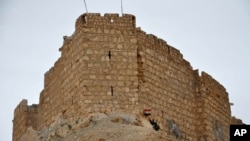Syria's army says the recapture of Palmyra will be a launching point for expanded operations against the Islamic State group, while the country's antiquities chief declared the already historic site will carry even greater significance as a survivor of the militants' campaign.
Backed by Russian airstrikes, pro-Syrian forces reclaimed control of Palmyra after a 10-month Islamic State occupation that included the destruction of several monuments dating back nearly 2,000 years.
The Britain-based Syrian Observatory for Human Rights said the offensive left 400 militants dead along with more than 180 pro-government fighters. President Bashar al-Assad hailed it as an "important achievement, and fresh proof of the efficiency of the Syrian army and its allies in fighting terrorism."
Damage assessment
State media said experts will be in Palmyra in the coming days to assess the damage done by the militants who have destroyed relics they deemed idolatrous in places they seized during the past two years in both Syria and Iraq.
Antiquities chief Maamoun Abdulkarim vowed to rebuild what Islamic State destroyed, including the Arch of Triumph and the Temple of Baalshamin. But he said other monuments in the Roman-era city were in good condition.
"A unique symbolism is now added to the world-famous historical city after having defied terrorism," said Abdulkarim, according to the state-run SANA news agency.
U.N. Secretary-General Ban Ki-moon said he was encouraged by Syria's plans to protect and restore Palmyra.
"This ISIS and extremists, terrorists, they have been not only killing brutally people, they've been destroying the human civilization's heritages -- thousands-year-long heritages -- which should be a common asset of whole humanity even though one may belong to Syria or elsewhere," Ban said, using an acronym for Islamic State.
WATCH: Aerial footage of Palmyra, Syria
IS flees
The remaining militants fled Palmyra to the east toward Deir Ezzor where they control a string of territory extending north through their de facto capital in Raqqa to the Turkish border and south to Iraq.
By seizing Palmyra, the Syrian government opened up the 100 kilometers of desert between there and Deir Ezzor.
The takeover of Palmyra is the latest in a series of setbacks for Islamic State. Iraq's army three months ago drove the extremist group out of the city Ramadi in neighboring Iraq. The Iraqi army also announced this week the start of a major offensive to retake the city of Mosul.
In Photos: Ancient City of Palmyra













